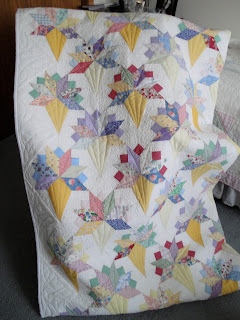Faced with hard times, women made scrap quilts to keep their families warm. Often they cut pieces from worn curtains, clothing, and bedding. They salvaged print fabrics from feed and flour sacks. Depression era quilt patterns, like Double Wedding Ring and Grandmother's Flower Garden were pieced from many small patches. Some historians think women used pastels to brighten the dark days of the depression and the dust bowl.
The woman who made this particular Nosegay quilt pieced the diamonds and inserted the small squares with precision. Although the quilt is made of scraps, the quilter chose prints and used one solid colors in each bouquet to create a design. She also alternated soft yellow and gold fabric in the nosegay cones. Even though I took good care of her quilt, it began to fray so I folded and wrapped it for storage.
In 199? I decided to make a replica. I counted the blocks, studied the pastel prints and solids and began to choose scraps. I cut diamonds from feed sacks, old fabrics purchased at second hand shops, and pieces I had inherited from another anonymous quilter. While sewing blocks by hand, I found two doll dresses my grandmother made for me and a cotton skirt she had sewed for her mother. I thought of my "can do" grandmother as I included her fabric in my quilt. I also incorporated some of my own new reproduction fabrics. Over the next three or four years, I pieced blocks. As best I could I replicated the color arrangement of the old quilt. After sewing the quilt top together, I put it away until I had time to stretch it on my frame for hand quilting. Several years went by but the time for hand quilting never materialized. Last August, I pulled the quilt top from a drawer and took it to a local woman for machine quilting.
This older but modern quilter lives on a farm outside of town. Together, we planned the quilting design. As we talked, I knew she had a good sense of quilts and quilting design. When I picked up the quilt in September, I was very pleased with her work. She showed me how she had arranged the quilt on the white backing fabric so I would have some nice leftover pieces. I didn't have the heart to tell her I was doing much more knitting and not likely to make another large quilt.
After the holidays, I was determined to attach the binding and finish the quilt. I considered a piece of bright blue fabric from my quilting supplies but the color looked too modern. I also considered piecing pastel fabrics to make a pieced binding but that design seemed too busy. When I spread the quilt on the floor to look at it again, I noticed the leftover backing along two sides of the quilt. I decided the leftover white fabric would work well for the binding so I got to work measuring, cutting, and sewing.
This morning when I began to write, I unwrapped the old quilt for photos and noticed the binding on three sides was cut from the same plain cream colored muslin backing the quilt. Without realizing it, I chose to bind the new quilt with leftover fabric in the same way the original quilter had finished her quilt. Although the pieces come from different eras and were made in different ways, they share many similarities. Perhaps most important, both quilts pay homage to the ingenuity and skills of women.





No comments:
Post a Comment